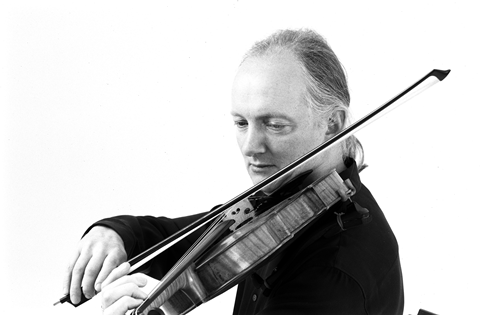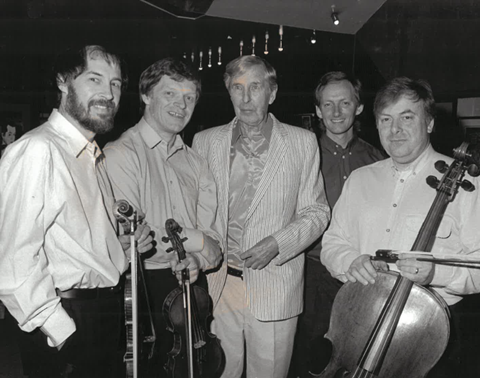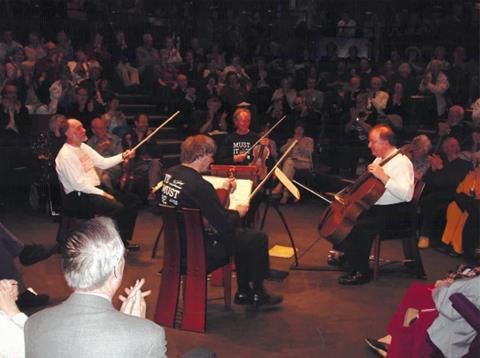Former violist of the Lindsay Quartet Robin Ireland looks back at the illustrious ensemble, which was renowned for its connection with audiences and a distinct affinity for the works of Beethoven

Read more Featured Stories like this in The Strad Playing Hub
2024 marks the 40th anniversary of Music in the Round’s Sheffield Chamber Music Festival, through which the Lindsays created the ideal vehicle for their vision of deepening the engagement between musicians and audience. The venue, the Crucible Studio (now renamed the Playhouse) allows the musicians to sit in the centre, with raked seating on four sides and two galleries. It seats 400, with no-one more than six metres from the musicians. This creates a concert experience of exceptional intimacy and intensity. Dressing informally was still relatively uncommon among classical musicians in the 1980s, as was the practice of talking to the audience about the music, and the Lindsays helped pioneer both. Starting from scratch, they turned Sheffield into arguably the most vibrant centre for chamber music in the UK outside London, with a devoted audience. When they disbanded in 2005, their place was taken by Ensemble 360, a superb and flexible ensemble of strings, piano and woodwind. This year’s festival, curated by Steven Isserlis, includes a retrospective of the Lindsays, which I’m delighted to be contributing to.
The members of the Lindsays were violinists Peter Cropper and Ronnie Birks, viola player Roger Bigley (I took his place in 1985), and cellist Bernard Gregor-Smith. We were fortunate to play on wonderful instruments: two Stradivarius violins (Golden Period and Long Pattern), a Brothers Amati viola and a Rugieri cello with the darkest and fullest-toned C string I have ever heard. The quartet developed an international career in which a rare balance was achieved between foreign touring, major UK venues and festivals and several annual series of six concerts within easy reach of Sheffield, as well as our own festival in Sheffield and occasional ones in London. We also benefitted from a residency, (something, alas, almost extinct in the UK today), at Manchester University. This structure enabled us to create wonderful themed programmes each year. It kept the repertoire fresh for us, and we benefitted from playing, returning to, and in most cases recording, almost all the quartets of the major composers from Haydn to Shostakovich and beyond. In addition, we premiered new works every year, most memorably the fourth and fifth quartets of Michael Tippett.

Peter Cropper was the charismatic first violinist and he was also the main force in building the quartet’s career and the vision behind it. He had the rare capacity to plan for the long term. He recognized that for a quartet to stay together required a good balance between career and family, and as a result we always took a month’s holiday in August and two weeks at Christmas and Easter, and restricted touring to two weeks at a time, to a maximum of ten weeks of the year. Few quartets have been able to lay down their priorities in this way.
As a violinist, Peter was sometimes referred to as the Mick Jagger of the string quartet, partly for his uninhibited style of performance, partly for an uncanny likeness in facial structure. David Fanning, a colleague at Manchester University, wrote of him: ‘It’s not ego or showmanship that pull’s Peter’s strings, but a combination of ecstasy and humility before the miracle of music. It’s as if Peter “disappears” in the act of performing, the music possessing him and playing through him’.
Read: Lindsay Quartet founding violinist Peter Cropper has died aged 69
Read: Ronald Birks, second violinist of the Lindsay Quartet, has died
All of us had strong and quite diverse musical personalities. We believed that the tensions created by our differences, when harnessed and prevented from spinning apart centrifugally, could bring a multi-dimensional richness to the music-making. It was by putting the composer before individual egos that this difficult integration could be achieved. I remember many occasions when disagreements of interpretation were not resolved in rehearsal, but almost magically found successful synthesis in a concert, something that went far beyond compromise. When I joined the quartet, Bernard, the cellist, said to me that he felt I would bring an Apollonian influence to their predominantly Dionysian energy. This perhaps exemplified their embracing of different qualities.
The Lindsays had an especially strong temperamental affinity with Beethoven. It came naturally to the quartet to respond to the extremes that characterize his personality and music. We played with total lack of inhibition, and many who heard us will attest to the sublimity we attained in the great slow movements. For me, the boundless intensity and energy of the Lindsays was a new discovery, and I grew immensely through it, even if in the end I remain a Mozartian. One critic wrote: ‘The Lindsays put truth before beauty and in doing so achieve both’.
Today’s squeaky-clean CD mentality has surely too often led to a levelling-out and a loss of individuality
It is no secret that by today’s standards the Lindsays did not always achieve technical perfection or perfectly clean intonation. This was also true of many great musicians of the early 20th century. The wonderful recordings from Casal’s Prades Festival bear witness to this. I for one continue to return to these recordings for their life-affirming musical inspiration. Today’s squeaky-clean CD mentality has surely too often led to a levelling-out and a loss of individuality, as the expectation of technical perfection inhibits musicians from musical creativity and risk-taking. There is no excuse for careless playing, needless to say. Yet perhaps a part of the Lindsay’s affinity for Beethoven, whose character led him to continual struggle with life, was helped rather than hindered by their own struggles to scale the heights of his masterpieces. Finding things easy does not always lead to the best results.
The other composer indelibly linked with the Lindsays is Haydn, father of the string quartet. His inexhaustible creativity, energy, humour and rootedness in elements of folk music (we called him an outdoors composer, by comparison with the more refined Mozart), made his music irresistibly attractive to us. Many people still think his music lacking in the emotional depth of Mozart, but neither Mozart himself nor we agreed. His music is such a great celebration of life in all its facets, and some of the slow movements tap into a depth of feeling second to none.

Unusually, our retirement as a quartet was planned three years in advance, and these final years were filled to the brim with concerts and Beethoven cycles to which we gave our all. The Lindsays’ final concert, in the Crucible Theatre, took place on 31 July 2005. The very last piece, almost inevitably, was Beethoven’s last quartet, with its enigmatic last movement prefaced by the words ‘Must it be? IT MUST BE!’.
Reflecting on the Lindsays’ 40 year career and the unique qualities they brought into being, it is clear that they were blessed by the times they lived in. Today’s world does not provide the same favourable conditions. There are many wonderfully communicative and creative young quartets performing today, thank goodness. They have a rougher road in many ways, and more obstacles. The Lindsays leave a legacy of memories and recordings in which their unique sonority, energy, spontaneity, emotional range and spiritual intensity live on.
The 40th Sheffield Chamber Music Festival runs Friday 17 to Saturday 25 May. Robin Ireland returns to play with Ensemble 360 on 20 May (Mozart and Schubert) at 2.30 and Paul Allen hosts a film screening of Remembering The Lindsays that evening at 7pm. Learn more here
Read: In pursuit of musical perfection: the legacy of the Lindsay Quartet
Read: Words of Wisdom: Cellist Bernard Gregor-Smith
Read more Featured Stories like this in The Strad Playing Hub
The number one source for playing and teaching books, guides, CDs, calendars and back issues of the magazine.
In The Best of Technique you’ll discover the top playing tips of the world’s leading string players and teachers. It’s packed full of exercises for students, plus examples from the standard repertoire to show you how to integrate the technique into your playing.
The Strad’s Masterclass series brings together the finest string players with some of the greatest string works ever written. Always one of our most popular sections, Masterclass has been an invaluable aid to aspiring soloists, chamber musicians and string teachers since the 1990s.
American collector David L. Fulton amassed one of the 20th century’s finest collections of stringed instruments. This year’s calendar pays tribute to some of these priceless treasures, including Yehudi Menuhin’s celebrated ‘Lord Wilton’ Guarneri, the Carlo Bergonzi once played by Fritz Kreisler, and four instruments by Antonio Stradivari.













































No comments yet